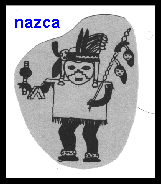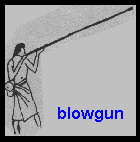
Headshrinking in South America
Shrinking a human head to the size of a baseball is a grisly but fascinating custom. It captures our interest and horrifies us at the same time. Like cannibalism, we are both appalled and magnetized by this seemingly savage act.

The custom of taking trophy heads in battle or war is widespread among many people in the world and goes back to prehistoric times, but shrinking the head is confined to isolated places in South America. In recent times we know of only a few tribes in Ecuador, Peru, and Brazil who continue this practice.
Ritual decapitation apparently has a long history in South America, dating as early as 200 BC. Many Nazca and Moche designs on pottery and textiles feature trophy heads, and the Nazca motifs in particular indicate that headshrinking might also have been practiced. This gruesome custom may well have been passed on to the Jivaro, whose territory is in the vicinity of these early civilizations.
Jivaro Culture
Most of the shrunken heads in museums were acquired from the Jivaro of Southern Ecuador. The Jivaro (pronounced hee-var-o) are one of the most feared tribes in South America, and according to the anthropologist, Michael Harner, have the reputation of being one of the only tribal groups in the world to have successfully repelled European invasions into their homeland. In 1599, an entire community of 20,000 Spanish settlers were massacred through a secretly planned attack on the governor's headquarters. The Spanish were there to mine gold, and the governor of the region sparked the revolt by heavily taxing the Jivaro for more of this precious metal. It is reported that the governor himself was executed by having molten gold poured into his mouth, while the Jivaro warriors asked, "Have you had your fill of gold now?"

The Jivaro live in scattered single family dwellings, isolated in the rainforests and eastern foothills of the Andes. The oval house often 80 feet in length, also serves as a kind of fortress against surprise attacks from enemies. Five or six such houses make up a village. Most of the food comes from gardens, which are abandoned every two to three years for new ones. The garden spot is chosen, the vegetation cut and burned, and many different food crops planted, particularly manioc, maize, beans, squash, and tobacco. The men hunt and fish, while the women tend the gardens and look after the children.
The Significance of Jivaro Headshrinking
Eagerly sought after by collectors, the shrunken head (called tsanta) of the Jivaro has achieved fame and notoriety. Because headhunting and headshrinking were outlawed first by the Spanish and later by the government of Ecuador, many of the recently collected shrunken heads of fakes. Even a real shrunken head may not be a true tsanta, since it has no ceremonial significance and is simply the head of a person who died by natural causes rather than one killed in a battle or raid. Although the heads of men, women, and children are taken, it is more frequently an adult warrior's head that is sought as tsanta. Because of Jivaro beliefs about the human soul, tsanta has magical power and symbolic significance.

The Jivaro believe a person may possess three "souls" or "essences". Everyone has an "ordinary soul" or "true soul" called nekas. Through visions, particularly with the aid of hallucinogenic drugs, a person acquired a second "soul", or arutam. The Jivaro believe that ordinary waking life is a "lie" or "false", and that only through the acquisition of arutam can a person enter the "real" or spiritual world. Jivaro babies are fed hallucinogenics to help them enter this real world. Once acquired, the arutam exists eternally. A third soul, call miusak, is linked to the acquired soul or arutam. It is the miusak, or "avenging soul", that has significance in the practice of headhunting and headshrinking.

The arutam gives a person power, intelligence, and self-confidence, but most importantly, it gives one eternal life. While the arutam is in the body, it is impossible for one to die to be killed. Death comes only when the arutam is away from the body, as in dreams.
If a person with arutam is killed, the acquired soul forms the miusak to avenge the death. Ordinary deaths of old age or disease do not give rise to miusak. It is this "avenging soul" that is captured in the shrunken head and thus its power of vengeance is neutralized.
Since women and children as well as men may possess an "acquired soul" that is capable of forming an "avenging soul" if killed, their heads are also taken and shrunk if killed in battle.
Because of these religious and magical beliefs of the Jivaro, the shrunken head is more to them than a battle trophy; the shrunken head holds power and prevents vengeance. Heads are shrunk as soon as possible on fleeing enemy territory in order to capture the "avenging soul". On arriving home with the shrunken heads, three tsanta feasts and rituals are held. During these rituals it is believed that the captured soul of the shrunken head emits power which is transmitted to others. It increases productivity in gardening and hunting. The ritual dances and feasts are concluded by expelling the "avenging soul" back to its neighborhood. The shrunken head then becomes nothing more than a trophy or symbol of power and may be sold or tossed away.
Head Shrinking
Shrinking the head is a lengthy process, requiring several hours. A slit is made in the back of the head, the skull removed and the skin scraped free of flesh. The eyes and lips are sewn shut. It is then cooked in an herbal solution for about two hours until shrunk to about 1/3 normal size. This also prevents the hair from falling out. After it is cooled the back of the neck is sewn and the cavity is successively filled with hot stones and sand to complete the shrinking process. The head is then hung over a smoldering fire overnight which turns the color from yellowish to black. It is then polished with ash and made ready for the tsanta rituals on entering the village.

The head of a victim is usually shrunk as soon as the raiding party achieves a safe distance from the victim's village. It is a dangerous business, since the party is on the run from the enemy. Once the heads are prepared a warrior is sent to inform the village and preparations are made for the tsanta feasts and rituals. The men enter the village with the shrunken heads tied around their necks. Women prepare bowls of blood and black paint to be applied to the left leg of each warrior who had taken a head. Later blood is smeared on the warrior's body, as a symbol those he has killed, and then the tsanta rituals begin.
Jivaro Warfare
Jivaro headshrinking is linked with Jivaro warfare, which is typical of other tribal groups in the area. The Jivaro believe that the acquisition of the arutam, or acquired soul, through visions frequently induced by hallucinogenics, leads to uncontrollable feelings of power and the need to go to battle.

Killing an enemy and shrinking his head brings the power of the victim's arutam to the killer. The more people one has killed, the more powerful one becomes. The killing of three or four people or more leads to the title kakaram, "powerful one" or "killer". Such men are both feared and respected and usually assume leadership in raids. A man with such a reputation is thought to be invincible, even by the enemy, and is seldom attacked either out of fear, or because it is thought useless due to his invincibility. The principle is much like that of détente on an individual level.
The Jivaro make a sharp distinction between "war", which is the raiding of a neighboring tribe where they "speak or act" differently, and "feuding", which involves fighting between individuals or closely related Jivaro villages. The motive for war is usually plunder and the desire to acquire heads with their associated spiritual power. The motive for the feud is usually to acquire women or for revenge on isolated males. In the feud heads are seldom taken.
A raid generally involved thirty or forty individuals who attempt to outnumber and surprise isolated homes, killing all the occupants for their heads and looting the household of machetes, shotguns, blowguns, dart poisons, hunting dogs, ornaments, and other things of value. The heads of those killed are taken and shrunk for the tsanta rituals.
The Jivaro live in expectation of retaliatory raids by the enemies. On the practical side they take a number of precautions. The men are always armed and the house is fortified, frequently by palisades built around the house. Warfare, headhunting, and revenge, at least traditionally, are accepted ways of life, much like we have learned to accept the frequent deaths and injuries due to automobile accidents in our machine-mobile society.
Suggested Readings
Michael Harner's book the Jivaro offers the best and most reliable descriptions of Jivaro culture, warfare, and the ritual significance of headshrinking. Many sensationalist and error-filled accounts of the Jivaro have been published, and the interested student should read with care.
Harner, Michael. The Jivaro: People of the Sacred Waterfalls. New York, Anchor Books, 1973.
Métraux, Alfred. "Warfare, Cannibalism, and Human Trophies." 383-409. Handbook of South America, 5. Washington, DC: US Government Printing Office, 1949.
Moser, Christopher. "Ritual Decapitation in Moche Art." Archaeology 27 (1974): 30-37.
Rivière, Peter. "Jivaro--Peru and Brazil." Peoples of the Earth, 6. Amazonia, Orinoco, and Pampas. The Danbury Press, 1973.
Acknowledgments
Exhibition text by Rex L. Jones and Catherine E. Ostlund. Illustrations adapted from Olga Kuthanová. Originally published as Pamphlet no. 1, Riverside Museum Press, April 1980.












